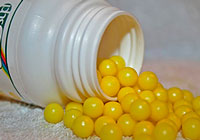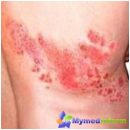And not even experiments. This is already everyday practice.
Content
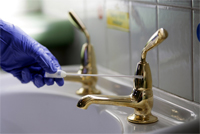 Scientists have long been looking for a method of constant and efficient prevention of bacterial prevention through touch surfaces. Contrary to common ideas, 80% of cases of infectious infections of a person account for precisely on the surface to which he touches. Used to reduce silver reduction target was not only expensive, but also had limited efficiency. Paradoxically, but the main efforts would be focused on the search for a new, synthetic substance, if it were not for concern with increasingly increasing mortality from infections acquired in hospital conditions caused by antibiotic strain staphylococcal stamped (MRSA), which received a weightless name «Super micker century».
Scientists have long been looking for a method of constant and efficient prevention of bacterial prevention through touch surfaces. Contrary to common ideas, 80% of cases of infectious infections of a person account for precisely on the surface to which he touches. Used to reduce silver reduction target was not only expensive, but also had limited efficiency. Paradoxically, but the main efforts would be focused on the search for a new, synthetic substance, if it were not for concern with increasingly increasing mortality from infections acquired in hospital conditions caused by antibiotic strain staphylococcal stamped (MRSA), which received a weightless name «Super micker century».
The known ability of surfaces from copper and copper alloys quickly suppress MRSA (99.9% COB for 2 hours), as well as the history of the use of copper for disinfection forced scientists to look more powerful to this material, applying the entire arsenal of modern techniques to identify bactericidal properties. And then surprising things turned out: under normal conditions (temperature, humidity), the surfaces of copper are superior to silver, and in the number of quickly and efficiently suppressed and inactivable microorganisms and the intestinal wand, and staphylococci, and even viruses in T.C. Flu Virus A: H1N1!
The effectiveness of copper has been established in the destruction or inactivation of various types of harmful bacteria, fungi and viruses, including:
- Akinetobacteria Baumannii (Acinetobacter Baumannii)
- Black Mold (Aspergillus Niger)
- Campylobacter (Campylobacter jejuni)
- Aerobacter (Enterobacter Aerogenes)
- Helicobacter Pylori (Helicobacter Pylori)
- Legionella (Legionella Pneumophilia)
- MPSZ (including E-MPSZ)
- Sinnaya wand (Pseudomonas Aeruginosa)
- Golden Staphylococcus (Staphylococcus aureus)
- Enterococcus, resistant to Vancomycin (Enterococcus Faecali)
- Adenovirus
Candida Albicans Fungus - Clostridium Difficile (Clostridium Difficile)
- Escherichia coli o157: h7)
- Virus of influenza type A (H1N1)
- Monocytogenic Listeria (Listeria Monocytogenes)
- Poliovirus
- Salmonella (Bacillus Gartner - Salmonella Enteriditis)
- Tubercle Bacillus (Tubercle Bacillus)
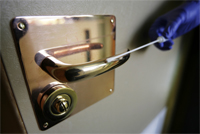 The Federal Agency for Environmental Protection of the United States (US EPA) After a series of mandatory studies, has registered copper as an antimicrobial surface, and the leading clinics began to conduct clinical trials in their infectious offices. In the UK, a scandal of meaningless multi-million expenses for the purchase of silver-containing preventive materials broke out, and the US Department of Defense conceived to equip their field hospitals with antimicrobial surfaces from copper – So extensively and efficiently antimicrobial effect of copper alloys.
The Federal Agency for Environmental Protection of the United States (US EPA) After a series of mandatory studies, has registered copper as an antimicrobial surface, and the leading clinics began to conduct clinical trials in their infectious offices. In the UK, a scandal of meaningless multi-million expenses for the purchase of silver-containing preventive materials broke out, and the US Department of Defense conceived to equip their field hospitals with antimicrobial surfaces from copper – So extensively and efficiently antimicrobial effect of copper alloys.
The impetus to the beginning of the production of sick and domestic use with the surfaces of the touch of copper alloys, among other things, became the economic arguments: costs are limited to the acquisition and installation of parts with copper surfaces, and useful effect is continuously 24 hours a day, 7 days a week, 365 days per year… (Photo 1, 2).
 Popularizers of the concept of applying antimicrobial copper conducted an experiment that was broadcast on-line: a group of researchers under the guidance of Professor Bila Kiwil from Southampton University demonstrated the comparative properties of antimicrobial surfaces from various materials. An experiment recording allows you to be visually convinced of the effectiveness of antimicrobial properties, the rate of suppression / inactivation of various microorganisms, and make their own judgment about the expediency of using such surfaces for themselves.
Popularizers of the concept of applying antimicrobial copper conducted an experiment that was broadcast on-line: a group of researchers under the guidance of Professor Bila Kiwil from Southampton University demonstrated the comparative properties of antimicrobial surfaces from various materials. An experiment recording allows you to be visually convinced of the effectiveness of antimicrobial properties, the rate of suppression / inactivation of various microorganisms, and make their own judgment about the expediency of using such surfaces for themselves.
To designate materials that have really confirmed antimicrobial properties, the International Copper Association registered (and monitors use) Special trademark ![]() .
.
 Today
Today ![]() This is not just a wide range of everyday and specialized utensils and items from balls to door handles and computer «Mouse». The system approach prompted, for example, the management of Santiago Metro is equipped transitions and stations by handrails and railing from antimicrobial copper (see. photo 3, 4, 5). Paradoxically, but the stations of the same Moscow metro once had similar, on the basis of copper alloy, railing, although at all other reasons. It is possible that not only the Moscow Metropolitan, but also other organizations with a large flow of people will return to the use of healthy materials in the premises and finishing.
This is not just a wide range of everyday and specialized utensils and items from balls to door handles and computer «Mouse». The system approach prompted, for example, the management of Santiago Metro is equipped transitions and stations by handrails and railing from antimicrobial copper (see. photo 3, 4, 5). Paradoxically, but the stations of the same Moscow metro once had similar, on the basis of copper alloy, railing, although at all other reasons. It is possible that not only the Moscow Metropolitan, but also other organizations with a large flow of people will return to the use of healthy materials in the premises and finishing.
It is important to remember that the antimicrobial effect is manifested only on the naked surface of the copper alloy – It is worth covering it with a varnish or dye, and direct contact with the metal will not, as well as antimicrobial action.
From «Antimicrobial copper. Often–Asked questions». Publication 201:
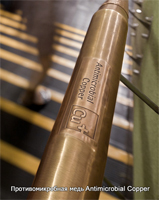 What means «Antimicrobial»?
What means «Antimicrobial»?
«Antimicrobial» means the ability of a substance to destroy or inactivate microorganisms such as bacteria, fungi (including mold fungi) and viruses.- How copper destroys pathogenic microorganisms?
Copper is an important nutritious element for a person, as well as for bacteria. In large doses of copper ions can cause a number of negative events in bacterial cells. The accurate mechanism for the destruction of bacteria copper has not yet been studied, but there are several theories. Among them:
- provoking potassium or glutamate leakage through the outer membrane of bacteria;
- disruption of the balance of osmotically active substances;
- binding with proteins that does not require copper;
- Provocation of oxidative stress by formation of hydrogen peroxide.
Laboratory studies have shown that copper alloys destroy 99.9% MRSS (MRSA) for two hours.
www.antimicrobialcopper.Org




